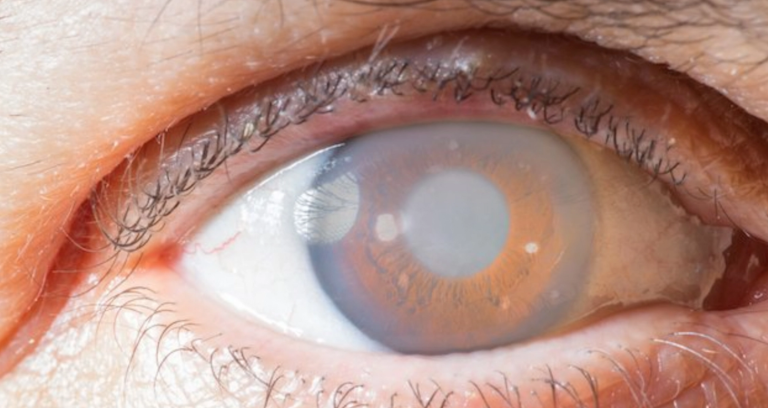Glaucoma is an eye illness that causes damage to the optic nerve, which can lead to visual loss that is permanent. It is one of the most common causes of blindness in those over the age of 60. Glaucoma is frequently linked to an increase in pressure in the eye.
A fluid called aqueous humor normally circulates around the eye. It’s largely water with a minor amount of nutrients to keep the cornea and lens healthy. This fluid drains through the trabecular meshwork at the corner where the cornea and iris meet after bathing the eye.
In glaucoma, either too much fluid is produced or it does not drain adequately. The fluid builds up inside the eye, causing pressure to rise and damage to the optic nerve.

Types of glaucoma
Glaucoma comes in three main forms:
1. Open-angle glaucoma: This is the most frequent type of the condition. It happens when small deposits build up in the drainage channels of the eye, gradually obstructing them. The canals look to be open and in good working order. The deposits, however, accumulate over months or years, causing fluid to build up which puts pressure on the optic nerve. Because most people don’t have symptoms, the condition might go unnoticed for years.
2. Angle-closure (Closed-angle) glaucoma: The trabecular meshwork narrows or becomes obstructed suddenly, causing a rapid increase in eye pressure.
3. Normal-tension glaucoma: Despite having normal eye pressure readings, the optic nerve is damaged.
Risk factors
- A family history of glaucoma
- Age (60 and over, or age 40 and over for African Americans)
- Increased eye pressure
- Thin cornea
- Very severe nearsightedness
- Eye surgery or injury
- High blood pressure or cardiovascular disease
- Diabetes
- Use of corticosteroid medicines
Glaucoma symptoms
Symptoms do not usually develop until the optic nerve has been severely injured. This is why this condition is known as the “quiet thief of sight.” Glaucoma causes blind spots in the peripheral (side) and central vision in its later stages.
Angle-closure glaucoma manifests itself abruptly, with symptoms such as these:
- Severe pain in the eye or forehead
- Blurred or reduced vision
- Nausea and vomiting
- Headache
- Eye redness
- Halos around lights
Anyone who has these symptoms should see an eye doctor as soon as possible.
Diagnosis
- Tonometry: measures pressure by blowing a puff of air into the eye.
- Pachymetry: is a measurement of the cornea’s thickness, which is the clear front section of the eye.
- Visual field test: the peripheral (side) vision is measured.
- Dilated eye exam: The optic nerve is examined with a light and magnifying glass.
- Gonioscopy: A unique mirrored lens is inserted into the eye to allow the doctor to observe the angle between the cornea and the iris.
Treatment
Glaucoma damage to the eyes is irreversible, so it’s critical to get treatment as soon as possible. Medicated eye drops, laser treatment, and surgery are all options for treating glaucoma, depending on the kind of glaucoma.
Eye drops
Eye drops relieve eye pressure in one of two ways. Some drops aid in the drainage of fluid from the eye:
- Prostaglandins – bimatoprost (Lumigan), latanoprost (Xalatan), and travoprost (Travatan Z)
- Rho kinase inhibitor – netarsudil (Rhopressa)
- Nitric oxides – latanoprostene bunod (Vyzulta)
- Miotic or cholinergic agents – pilocarpine (Isopto Carpine)
Other drops reduce the amount of fluid produced by the eye:
- Alpha-adrenergic agonists – apraclonidine (Iopidine) and brimonidine (Alphagan P, Qoliana)
- Beta blockers – betaxolol (Betoptic) and timolol (Betimol, Istalol, Timoptic)
- Carbonic anhydrase inhibitors – brinzolamide (Azopt) and dorzolamide (Trusopt)
These drugs may cause the following side effects:
- Stinging, burning, or redness in the eye
- Blurry vision
- Red skin around the eyes
- Dry mouth
- Changes in energy level, breathing, or heartbeat.
Laser surgery
The fluid in the eye is allowed to drain through an opening created by laser surgery. The kind of glaucoma determines which procedure is used:
- Trabeculoplasty treats open-angle glaucoma
- Iridotomy treats angle-closure glaucoma
The effects of laser surgery may take four to six weeks to manifest, and not everyone will see improvement. Dryness, edema, and discomfort are all possible side effects of surgery.
Open Surgery
Doctors can undertake open surgery to construct a new channel for the aqueous humor to drain if drugs and laser surgery don’t work or aren’t an option for open-angle glaucoma.
Trabeculectomy is a procedure that involves cutting a small aperture in the sclera (the white area of the eye) beneath the eyelid, where it is not visible. In the clear part in front of the sclera – the conjunctiva – the surgeon also makes a little bubble called a bleb. The fluid then flows out of the eye and into the bleb via the flap.




